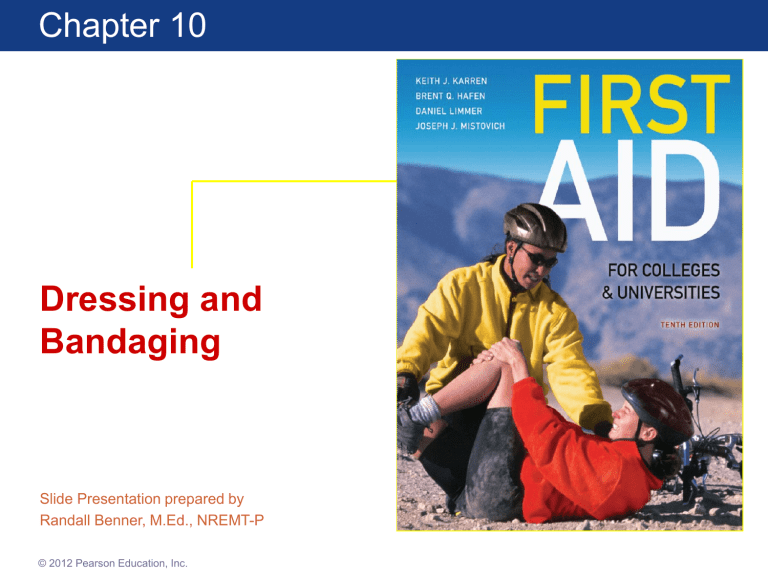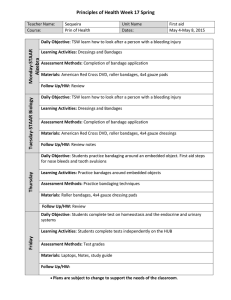
Chapter Lecture Chapter110 Book Title Edition Dressing and Bandaging Slide Presentation prepared by Randall Benner, M.Ed., NREMT-P © 2012 Pearson Education, Inc. Learning Objectives • Identify the various types of dressings and bandages. • Demonstrate how to apply various types of bandages to different parts of the body. • Describe the basic principles of dressing and bandaging wounds. • Demonstrate how to apply a pressure bandage, and how to use a sling. © 2012 Pearson Education, Inc. Dressings • A dressing is a sterile covering for a wound • All open wounds should be covered to – Prevent infection – Control bleeding – Prevent further injury • Large or deep wounds should always be cleaned and treated at a medical facility; don’t try to clean them yourself. • Note: A dressing is a sterile wound covering; a bandage holds a dressing in place. © 2012 Pearson Education, Inc. Dressings • Dressings should be – Sterile (microorganism- and spore-free) – Aseptic (bacteria-free) – Held in place with a bandage firmly enough to control bleeding, but not stop circulation (i.e., not too tight) – Larger than the wound – Soft, thick, and compressible – Most are porous, allowing air to circulate – Ideally, layered, lint-free, gauzy, and somewhat bulky – Always placed against the wound and held by bandage; the bandage should never directly touch the wound © 2012 Pearson Education, Inc. Types of Commercial Dressings • Occlusive: have an airtight and waterproof seal; used for specific types of chest wounds • Compress: thick, bulky, usually sterile, intended to stop bleeding • Trauma: larger area, thick, sterile, absorbent; used for more serious or widespread injury • Adhesive strips: combination sterile dressing and bandage, individually packaged; used for small wounds • Adhesive tape: commonly unsterile, comes in varying-width rolls, not applied directly to wounds; holds dressings in place © 2012 Pearson Education, Inc. Types of Commercial Dressings • Gauze pads: used in various dressings, may have coating to prevent sticking; the portion applied to a wound should be sterile • Special pads: commonly used for larger-area trauma; also called multitrauma pads • Bandage compresses: special dressing used to cover wounds and help control heavy bleeding © 2012 Pearson Education, Inc. Bandages • The most common type is an adhesive strip (Band-Aid) • Bandages must – – – – – – Hold a dressing in place over a wound. Create pressure that controls bleeding. Help keep the edges of a wound closed. Secure a splint to an injured body part. Provide support for an injured body part. Help prevent or reduce swelling. © 2012 Pearson Education, Inc. Bandages • The most common mistakes are applying bandages too tightly or too loosely • Signs that a bandage is too tight – – – – Nearby skin becomes pale or a bluish color Nearby fingernails/toenails develop a bluish tinge Skin beyond the bandage is cold, tingling, or numb If you press on the nail bed and let go, it does not quickly turn pink again – The victim cannot move their fingers or toes © 2012 Pearson Education, Inc. Types of Bandages • Triangular – Unbleached cotton, cut in triangle shape – Easy to apply – Can be used on most parts of the body • Cravat – A folded triangular bandage • Roller – Made from gauze-like material – Comes in different widths, making it flexible – Most popular is self-adhering (nonelastic) and formfitting © 2012 Pearson Education, Inc. Triangular and Cravat Bandages © 2012 Pearson Education, Inc. Dressing and Bandaging Principles • Handle carefully to prevent contamination. • Don’t apply bandages until bleeding has stopped. • Don’t remove original dressing if blood soaks through. • Ensure that the dressing completely covers the wound. • Do not place bandages directly on wounds (only sterile dressings). • Bandage wounds snugly but not tightly. © 2012 Pearson Education, Inc. Dressing and Bandaging Principles • Bandages should not be loose; dressing and bandage should not slip or shift. • Ensure that there are no loose ends that could catch on things. • Cover all edges of the dressing with the bandage. • Leave tips of fingers and toes exposed when bandaging arms and legs. • Bandage a body part in the position it should remain. • Never use a circular bandage around a victim’s neck. © 2012 Pearson Education, Inc. Improvising Dressings and Bandages • Some situations require improvisation. • No hard-and-fast rules; use adaptability and creativity. • Use materials on hand and methods you can best adapt. • Use materials that are as clean as possible. • Never touch the wound directly. • Control bleeding. © 2012 Pearson Education, Inc. Improvising • In an emergency can use if clean – – – – – Handkerchief Washcloth or towel Sheet or pillowcase Sanitary napkin Plastic wrap can be used as part of an occlusive dressing • Never use – Elastic bandages – Fluffy cotton or cotton balls – Paper towels, toilet tissue, or other materials cling when wet © 2012 Pearson Education, Inc. Special Dressing and Bandages • Pressure dressings – Apply snugly enough to create pressure on wound. • Slings – Used to support injuries of shoulder, arm, or rib. – If available, use a triangular bandage. © 2012 Pearson Education, Inc. Summary • A dressing is a sterile cover for a wound. • The ideal dressing is sterile, gauzy, and layered. • Never use materials that could cling to, shred on, or disintegrate over a wound as a dressing. • A bandage holds a dressing in place and does not touch the wound. • Bandages should not be too tight or too loose. © 2012 Pearson Education, Inc.



